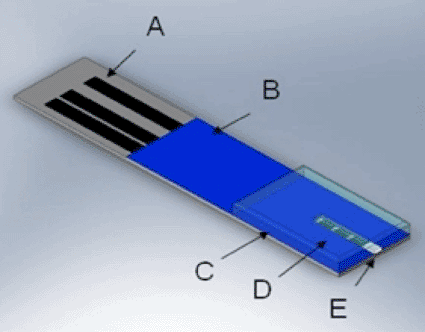The Days of Glucose Finger Prick Tests May Be Numbered
By LabMedica International staff writers
Posted on 14 Apr 2011
Consistent blood glucose monitoring based on painful finger pricking could soon be a thing of the past, thanks to a novel prototype sensor that will measure the amount of glucose in a tear drop. Posted on 14 Apr 2011
Researchers at Arizona State University (ASU; Phoenix, USA) and the Mayo Clinic (Rochester, MN, USA) are developing the new sensor, which has already demonstrated proof-of-concept, as the amount of glucose in tears closely correlates with the amount of glucose in the blood. The device incorporates screen-printed sensors integrated with a silicone rubber fluidics system and absorbent polyurethane foam. In laboratory tests, a simulated eye surface was prepared using fluid-saturated poly(2-hydroxyethyl methacrylate) sheets; the disposable prototype was then tested for both reproducibility at 0 µmol/L, 200 µmol/L, and 400 µmol/L glucose and dynamic range of glucose detection from 0 µmol/L to 1000 µmol/L glucose.

Image: Screen-printed electrical leads (A), an insulating layer (B), a silicone fluidics piece (C), a sensing well covering the three electrode system (D), and an absorbent sampling material (E) are the main components of the glucose lacrimation device. (Photo courtesy of Arizona State University).
Testing of the integrated prototype demonstrated a satisfactory lower limit of detection for measuring glucose concentration in tears, and was reproducible across a physiological sampling range. The next step in the device design process will be initial animal studies to evaluate the current prototype for factors such as eye irritation, ease of use, and correlation with blood glucose. The major challenges now facing the researchers are performing the test quickly, efficiently, with reproducible results, without letting the test sample evaporate, and without stimulating a stress response that causes people to rub their eyes intensely.
"The problem with current self-monitoring blood glucose technologies is not so much the sensor,” said codeveloper bioengineer Jeffrey LaBelle, PhD, of ASU. "It's the painful finger prick that makes people reluctant to perform the test. This new technology might encourage patients to check their blood sugars more often, which could lead to better control of their diabetes by a simple touch to the eye.”
Because of its potential impact on health care, the technology has drawn interest from BioAccel (Phoenix, USA), a nonprofit organization that works to accelerate efforts to bring biomedical technologies to the marketplace. BioAccel will provide assistance using a network of technical and business experts, while the researchers will compile the proper data set to allow for approval of human testing of the device.
"A critical element to commercialization is the validation of technology through proof-of -concept testing,” said Nikki Corday, BioAccel business and development manager. "Positive results will help ensure that the data is available to help the research team clear the technical hurdles to commercialization.”
Related Links:
Arizona State University
Mayo Clinic
BioAccel













